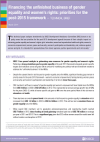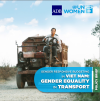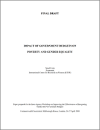أسس 18
This call for Action was issued following the meeting on “Gender and Development: Towards Effective, Inclusive Development” Organized by the Ministry of Foreign Affairs and Trade, Republic of Korea and co-hosted by UN Women, in July 2011.
Since the start of the COVID-19 pandemic, almost USD 16 trillion has been pumped into the global economy, and governments are now rolling out second and third ph
The final report of the Commission on a Gender-Equal Economy has been released at a unique moment in global history.
Recent reforms of aid delivery, most notably the Paris Declaration on Aid Effectiveness (2005), have provided new opportunities and mechanisms to translate donor and government commitments into improved practice results and impacts.
This note provides an overview of existing gender equality markers and reviews issues relating to the tracking and monitoring of investments related to gender equality and women’s empowerment.
This technical paper analyses investments by OECD Development Assistance Committee (DAC) donors in six policy areas that are priorities for the post-2015 development agenda because of their catalytic impact on achieving gender equality and women’s rights: girls’ education; sexual and reproductive he
The guidance note sets out commom principles and standards for gender equality markers systems that track and report on allocations and expenditures for gender equality and women's empowerment.
This UN Women Policy Brief presents a set of recommendations to achieve a gender-responsive economic recovery in Lebanon, and are compiled from a larger forthcoming analysis of the gendered impact of Lebanon’s economic crisis on different aspects of women’s life.
Transport is one of the most important aspects of national infrastructure and a key to gender equality. Women’s opportunities to access paid work are reduced when there is poor investment in gender
In this paper, Simel Esim (2000) focuses on expenditure and revenue instruments of fiscal policy as strategic entry points for engendering macroeconomics. The paper also includes a discussion of the potential implications of monetary policy and overall fiscal stance on poverty and gender equality.







